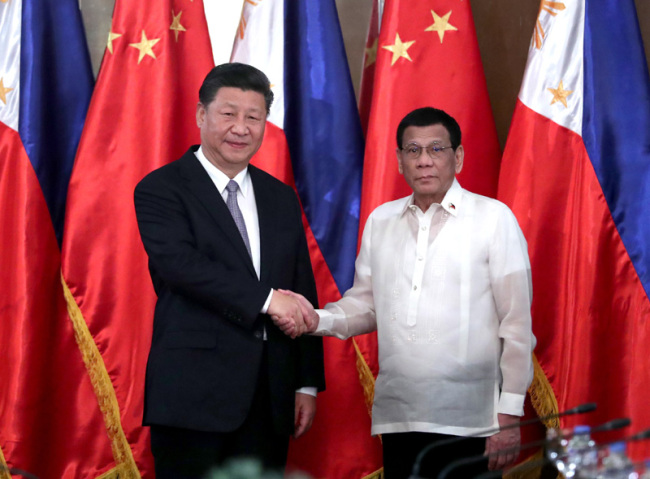Note: The following is an edited translation of a commentary from the Chinese-language "Commentaries on International Affairs."
After years of hardship, China-Philippines relations have currently reached a new level. Chinese President Xi Jinping and Philippine President Rodrigo Duterte held talks on Tuesday (20th) and decided to establish a comprehensive, strategic and cooperative relationship between China and the Philippines.

Chinese President Xi Jinping (L) meets with his Philippine counterpart Rodrigo Duterte in Manila on Tuesday, November 20, 2018. [Photo: Xinhua]
In 2005, China and the Philippines planned to forge a strategic and cooperative relationship for peace and development. However, efforts toward this goal were forced to cease when the South China Sea dispute was triggered by some powers from outside the region, and the former Philippine government unilaterally initiated the South China Sea arbitration.
In 2016, after taking office, President Duterte started to pursue an independent foreign policy. China and the Philippines got back on track to solving the South China Sea issue through dialogue and consultation. Since then, President Xi Jinping and President Duterte have had six meetings. Under the joint leadership of the two heads of state, bilateral relations have opened a new chapter.
The Filipino President has come up with economic strategies surrounding the 180-billion-dollar "Build Build Build" plan in a bid to rejuvenate infrastructure in the country. The plan shares natural similarities with China's "Belt and Road" Initiative, which aims to improve connectivity on a trans-continental scale through infrastructure investment and regional cooperation. Two years ago, President Duterte visited Beijing and the two countries signed a cooperative agreement worth 24 billion dollars, with a primary focus on construction within the Philippine nation.
In addition to infrastructure construction, China-Philippines economic and trade relations have also made tremendous headway over the past two years. China has become the Philippines' largest trading partner, the largest source of imports, and the second largest source of tourists. Last year, bilateral trade volume exceeded 50 billion US dollars for the first time. China's direct investment in the Philippines exceeded 53 million dollars, an increase of 67% over the previous year. Through August this year, direct investment from China reached as high as 180 million U.S. dollars.
While the two sides continue to consolidate cooperation in the field of economics, China also firmly supports the anti-drug and anti-terrorism undertakings led by Duterte in the realm of national security.
It is noteworthy that while the heads of state decided to upgrade the strategic cooperation between the two countries, they also witnessed the signing of several collaborative agreements, including an MOU on joint promotion of the Belt and Road Initiative and another on oil and gas exploration cooperation. The agreement on offshore oil and gas development has drawn much attention.
In July of last year, the Philippine side stated that in the light of the concept of "setting aside dispute and pursuing joint development" put forward in 1986 by both sides on the South China Sea issue, Manila believes that both sides will find ways to jointly develop natural resources for the benefit of the peoples under the leadership of Presidents Duterte and Xi Jinping. In response, Chinese Foreign Minister Wang Yi said that the two countries should come up with a decision involving the implementation of this agreement at an early date so as to benefit the two nations.
In October this year, Wang Yi once again drew attention to the political wisdom in "setting aside dispute and pursuing joint development," a proposal China put forward 32 years ago. If both countries can achieve joint development without affecting their respective sovereign claims, it will not only help the Philippines to alleviate the possible energy shortages in the future, but also provide a pragmatic way for China and the Philippines to properly handle their disputes, and at the same time set a good example for other countries in the region.
The two sides are turning the political wisdom 32 years ago into joint action. As mentioned by President Xi Jinping, China and the Philippines share extensive common interests on the South China Sea, and the two countries are able to continue to manage differences through friendly consultations, promote practical cooperation on the sea and make due contribution to regional peace, stability and the welfare of the people.
President Duterte said that President Xi Jinping's state visit to his country, the first by a Chinese head of state in 13 years, is of historic significance in bilateral relations and will open a new chapter in their cooperation. He stressed that the Philippine nation agrees that countries in the region should jointly safeguard peace and stability of the South China Sea. He said that China has stood on the right side of history in dealing with international affairs, and that the Philippine side is ready to carry out closer communication and coordination with China within multilateral frameworks such as the United Nations.
All signs are showing that President Xi Jinping's visit not only boosted bilateral ties and consolidated political mutual trust, but also set a model for promoting pragmatic maritime cooperation between China and ASEAN countries.

















